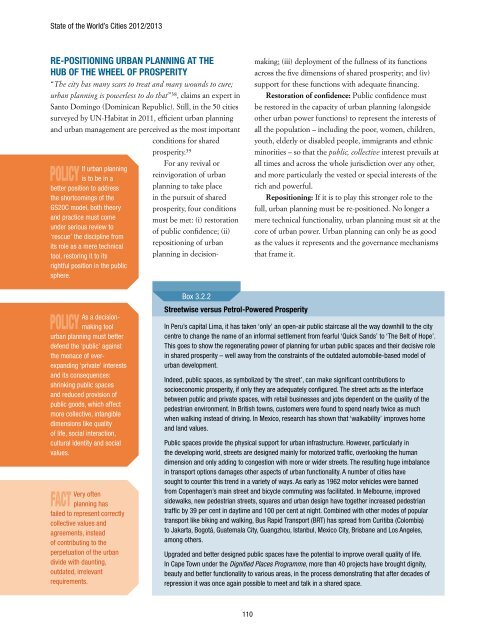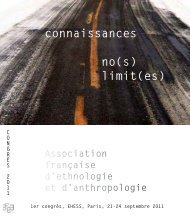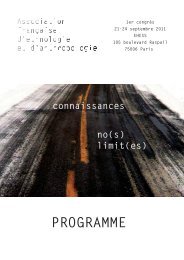state of the world's cities 2012/2013 - United Nations Sustainable ...
state of the world's cities 2012/2013 - United Nations Sustainable ...
state of the world's cities 2012/2013 - United Nations Sustainable ...
You also want an ePaper? Increase the reach of your titles
YUMPU automatically turns print PDFs into web optimized ePapers that Google loves.
State <strong>of</strong> <strong>the</strong> World’s Cities <strong>2012</strong>/<strong>2013</strong>Re-positioning Urban Planning at <strong>the</strong>Hub <strong>of</strong> <strong>the</strong> Wheel <strong>of</strong> Prosperity“The city has many scars to treat and many wounds to cure;urban planning is powerless to do that” 38 , claims an expert inSanto Domingo (Dominican Republic). Still, in <strong>the</strong> 50 <strong>cities</strong>surveyed by UN-Habitat in 2011, efficient urban planningand urban management are perceived as <strong>the</strong> most importantconditions for sharedprosperity. 39For any revival orIf urban planningpolicyreinvigoration <strong>of</strong> urbanis to be in abetter position to address planning to take place<strong>the</strong> shortcomings <strong>of</strong> <strong>the</strong> in <strong>the</strong> pursuit <strong>of</strong> sharedGS20C model, both <strong>the</strong>ory prosperity, four conditionsand practice must come must be met: (i) restorationunder serious review to<strong>of</strong> public confidence; (ii)‘rescue’ <strong>the</strong> discipline fromrepositioning <strong>of</strong> urbanits role as a mere technicaltool, restoring it to itsplanning in decision-rightful position in <strong>the</strong> publicsphere.making; (iii) deployment <strong>of</strong> <strong>the</strong> fullness <strong>of</strong> its functionsacross <strong>the</strong> five dimensions <strong>of</strong> shared prosperity; and (iv)support for <strong>the</strong>se functions with adequate financing.Restoration <strong>of</strong> confidence: Public confidence mustbe restored in <strong>the</strong> capacity <strong>of</strong> urban planning (alongsideo<strong>the</strong>r urban power functions) to represent <strong>the</strong> interests <strong>of</strong>all <strong>the</strong> population – including <strong>the</strong> poor, women, children,youth, elderly or disabled people, immigrants and ethnicminorities – so that <strong>the</strong> public, collective interest prevails atall times and across <strong>the</strong> whole jurisdiction over any o<strong>the</strong>r,and more particularly <strong>the</strong> vested or special interests <strong>of</strong> <strong>the</strong>rich and powerful.Repositioning: If it is to play this stronger role to <strong>the</strong>full, urban planning must be re-positioned. No longer amere technical functionality, urban planning must sit at <strong>the</strong>core <strong>of</strong> urban power. Urban planning can only be as goodas <strong>the</strong> values it represents and <strong>the</strong> governance mechanismsthat frame it.policyAs a decisionmakingtoolurban planning must betterdefend <strong>the</strong> ‘public’ against<strong>the</strong> menace <strong>of</strong> everexpanding‘private’ interestsand its consequences:shrinking public spacesand reduced provision <strong>of</strong>public goods, which affectmore collective, intangibledimensions like quality<strong>of</strong> life, social interaction,cultural identity and socialvalues.factVery <strong>of</strong>tenplanning hasfailed to represent correctlycollective values andagreements, instead<strong>of</strong> contributing to <strong>the</strong>perpetuation <strong>of</strong> <strong>the</strong> urbandivide with daunting,outdated, irrelevantrequirements.Box 3.2.2Streetwise versus Petrol-Powered ProsperityIn Peru’s capital Lima, it has taken ‘only’ an open-air public staircase all <strong>the</strong> way downhill to <strong>the</strong> citycentre to change <strong>the</strong> name <strong>of</strong> an informal settlement from fearful ‘Quick Sands’ to ‘The Belt <strong>of</strong> Hope’.This goes to show <strong>the</strong> regenerating power <strong>of</strong> planning for urban public spaces and <strong>the</strong>ir decisive rolein shared prosperity – well away from <strong>the</strong> constraints <strong>of</strong> <strong>the</strong> outdated automobile-based model <strong>of</strong>urban development.Indeed, public spaces, as symbolized by ‘<strong>the</strong> street’, can make significant contributions tosocioeconomic prosperity, if only <strong>the</strong>y are adequately configured. The street acts as <strong>the</strong> interfacebetween public and private spaces, with retail businesses and jobs dependent on <strong>the</strong> quality <strong>of</strong> <strong>the</strong>pedestrian environment. In British towns, customers were found to spend nearly twice as muchwhen walking instead <strong>of</strong> driving. In Mexico, research has shown that ‘walkability’ improves homeand land values.Public spaces provide <strong>the</strong> physical support for urban infrastructure. However, particularly in<strong>the</strong> developing world, streets are designed mainly for motorized traffic, overlooking <strong>the</strong> humandimension and only adding to congestion with more or wider streets. The resulting huge imbalancein transport options damages o<strong>the</strong>r aspects <strong>of</strong> urban functionality. A number <strong>of</strong> <strong>cities</strong> havesought to counter this trend in a variety <strong>of</strong> ways. As early as 1962 motor vehicles were bannedfrom Copenhagen’s main street and bicycle commuting was facilitated. In Melbourne, improvedsidewalks, new pedestrian streets, squares and urban design have toge<strong>the</strong>r increased pedestriantraffic by 39 per cent in daytime and 100 per cent at night. Combined with o<strong>the</strong>r modes <strong>of</strong> populartransport like biking and walking, Bus Rapid Transport (BRT) has spread from Curitiba (Colombia)to Jakarta, Bogotá, Guatemala City, Guangzhou, Istanbul, Mexico City, Brisbane and Los Angeles,among o<strong>the</strong>rs.Upgraded and better designed public spaces have <strong>the</strong> potential to improve overall quality <strong>of</strong> life.In Cape Town under <strong>the</strong> Dignified Places Programme, more than 40 projects have brought dignity,beauty and better functionality to various areas, in <strong>the</strong> process demonstrating that after decades <strong>of</strong>repression it was once again possible to meet and talk in a shared space.110





